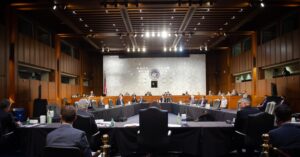Todd Harrison, director of the Aerospace Security Project at the Center for Strategic and International Studies, said the report “conflates space capabilities in general with space capabilities that are potential threats.”
The U.S. intelligence community’s annual threat assessment published April 13, for example, mentions Chinese civilian space programs such as a future space station and a network of navigation satellites as capabilities that China is pursuing that could be a threat to the United States.
“The U.S. government needs to be clear about which Chinese space developments pose a threat and are a security concern — and there are many — and which developments merely show that China is pursing an ambitious civil space program to catch up to where the United States was 20 or 30 years ago,” Harrison told SpaceNews.
China’s space station, Harrison believes, is a positive development. “It gives them a good reason not to trash low Earth orbit with a bunch of space junk.”
Victoria Samson, Washington Office director at the Secure World Foundation, questioned why the intelligence community listed China’s space station as a threat even though it’s been planned for more than a decade. “I didn’t know that a space station was a sign of nefarious intent for space,” Samson tweeted April 15.
John Klein, adjunct professor at George Washington University’s Space Policy Institute, said it’s a constant debate whether intelligence agencies overstate or exaggerate the potential threat posed by China.
With regard to space, it’s a valid concern because China doesn’t separate military from civil or commercial activities like the United States and many Western countries do, Klein said.
The problem with China is knowing their “intent,” Klein said. “I don’t consider China’s current space activities to be actual aggression in a military context but I do think it is in the national security interests of the U.S. government to continue to monitor, seek greater transparency, and address appropriately China’s current and future space activities and capabilities development.”
Peter Garretson, a retired U.S. Air Force officer and a writer on space policy and strategy, said the intelligence community views China’s space program as one that “seeks dual-use and civil-military integration at all levels.”
For China, “space resources are key to their long-term development and power, and have focused their exploration and development goals toward their exploitation,” Garretson said.
He said it would be irresponsible for the U.S. intelligence community to turn a blind eye to clearly stated Chinese ambitions to be the dominant space power.
“There are absolutely valid concerns that China is using, or could use, its civilian space program as a guise for military developments, but it’s more complicated than simply some nefarious space engineer wearing a People’s Liberation Army uniform under her lab coat,” noted Joshua Huminski, director of the national security space program at the Mike Rogers Center for Intelligence and Global Affairs.
A country can develop a satellite capable of conducting rendezvous and proximity operations for refueling or debris removal, but that same technology can be used to attack an adversary’s satellite, degrade its orbit, or simply get close enough to have a look, Huminski said.
Repurposing a rocket’s second stage for commercial or scientific use has military applications such as hosting payloads or sensors, he said.
“It’s important that we don’t conflate capabilities with threats,” Huminski said. “But it would be foolish not to see the potential dual-use of platforms and systems.”
Dean Cheng, senior research fellow at the Heritage Foundation’s Davis Institute for National Security and Foreign Policy, said it’s clear that Chinese space technology development will benefit their military.
China’s space infrastructure is run by the People’s Liberation Army, said Cheng. “This includes all of their launch sites, their mission control centers, and their TT&C (telemetry, tracking, and control) facilities.”
There is no credible evidence, he said, that the Jiuquan Satellite Launch Center where China’s missions are launched, or the new Hainan facility where heavy launch vehicles are launched, are not run by the PLA.



